Investigation of Energy and Environmental Potentials of a Renewable Trigeneration System in a Residential Application
Abstract
:1. Introduction
2. Renewable Trigeneration System for Investigation
3. Methodology
3.1. Energy Analysis Methodology
3.2. Environmental Analysis Methodology
4. Simulation Models and Assumptions
4.1. TRNSYS Models
4.2. House Specifications and Thermal Loads
4.3. Equipment Capacity and Specifications
4.4. Control Approaches
4.5. Weather Data and Simulation Period
5. Results and Discussion
5.1. Thermal Loads
5.2. Electricity and Natural Gas Consumption
5.3. Primary Energy Consumption
5.4. Overall Primary Energy Savings
5.5. Overall System Performance
5.6. Greenhouse Gas Emission
6. Conclusions
7. Future Work
Acknowledgments
Author Contributions
Conflicts of Interest
References
- European Parliament; Council of the European Union. Directive 2004/8/EC of the European Parliament and of the Council of the 11 February 2004 on the promotion of cogeneration based on the useful heat demand in the internal energy market and amending Directive 92/42/EEC. Off. J. Eur. Union 2004, 47, 50–60. [Google Scholar]
- Maghanki, M.M.; Ghobadian, B.; Najafi, G.; Galogah, R.J. Micro combined heat and power (MCHP) technologies and applications. Renew. Sustain. Energy Rev. 2013, 28, 510–524. [Google Scholar] [CrossRef]
- Evangelisti, S.; Lettieri, P.; Clift, R.; Borello, D. Distributed generation by energy from waste technology: A life cycle perspective. Process Saf. Environ. Prot. 2015, 93, 161–172. [Google Scholar] [CrossRef]
- Angrisani, G.; Roselli, C.; Sasso, M. Distributed microtrigeneration systems. Prog. Energy Combust. Sci. 2012, 38, 502–521. [Google Scholar] [CrossRef]
- Sonar, D.; Soni, S.L.; Sharma, D. Micro-trigeneration for energy sustainability: Technologies, tools and trends. Appl. Therm. Eng. 2014, 71, 790–796. [Google Scholar] [CrossRef]
- Barbieri, E.; Spina, P.; Venturini, M. Analysis of innovative micro-CHP systems to meet household energy demands. Appl. Energy 2012, 97, 723–733. [Google Scholar] [CrossRef]
- Moghaddam, A.A.; Seifi, A.; Niknam, T.; Pahlavani, M.R.A. Multi-objective operation management of a renewable MG (micro-grid) with back-up micro-turbine/fuel cell/battery hybrid power source. Energy 2011, 36, 6490–6507. [Google Scholar] [CrossRef]
- Shaneb, O.; Coates, G.; Taylor, P. Sizing of residential μCHP systems. Energy Build. 2011, 43, 1991–2001. [Google Scholar] [CrossRef]
- Kim, J.; Cho, W.; Lee, K. Optimum generation capacities of micro combined heat and power systems in apartment complexes with varying numbers of apartment units. Energy 2012, 35, 5121–5131. [Google Scholar] [CrossRef]
- Dorer, V.; Weber, A. Energy and CO2 emissions performance assessment of residential micro-generation systems with dynamic whole-building simulation programs. Energy Convers. Manag. 2009, 50, 648–657. [Google Scholar] [CrossRef]
- Gusdorf, J.; Douglas, M.; Swinton, M.; Szadkowski, F.; Manning, M. Testing a residential system including combined heat and power and ground heat source heat pumps at the Canadian Centre for Housing Technology. In Proceedings of the 1st International Conference on Microgeneration and Related Technologies, Ottawa, ON, Canada, 10–14 March 2008.
- Yang, L.; Douglas, M.A.; Gusdorf, J.; Szadkowski, F.; Limouse, E.; Manning, M.; Swinton, M. Residential total energy system testing at the Canadian Center for Housing Technology. In Proceedings of the ASME 2007 Power Conference, San Antonio, TX, USA, 17–19 July 2007.
- Smith, M.; Few, P. Domestic-scale combined heat-and-power system incorporating a heat pump: Analysis of a prototype plant. Appl. Energy 2011, 70, 215–232. [Google Scholar] [CrossRef]
- Tempesti, D.; Manfrida, G.; Fiaschi, D. Thermodynamic analysis of two micro CHP systems operating with geothermal and solar energy. Appl. Energy 2012, 97, 609–617. [Google Scholar] [CrossRef]
- Guo, T.; Wang, H.; Zhang, S. Selection of working fluids for a novel low temperature geothermally-powered ORC based cogeneration system. Energy Convers. Manag. 2011, 52, 2384–2391. [Google Scholar] [CrossRef]
- Ribberink, H.; Lombardi, K.; Yang, L.; Entchev, E. Hybrid renewable-microgeneration energy system for power and thermal generation with reduced emissions. In Proceedings of the 2nd International Conference on Microgeneration and Related Technologies, Glasgow, UK, 1–3 April 2011.
- Hawkes, A.; Leach, M. Cost-effective operating strategy for residential micro-combined heat and power. Energy 2007, 32, 711–723. [Google Scholar] [CrossRef]
- Entchev, E.; Gusdorf, J.; Swinton, M.; Bell, M.; Szadkowski, F.; Kalbfleisch, W.; Marchand, R. Micro-generation technology assessment for housing technology. Energy Build. 2004, 36, 925–931. [Google Scholar] [CrossRef]
- Hamada, Y.; Takeda, K.; Goto, R.; Kubota, H. Hybrid utilization of renewable energy and fuel cells for residential energy systems. Energy Build. 2011, 43, 3680–3684. [Google Scholar] [CrossRef]
- International Energy Agency, Energy Conversion in Buildings and Community System Program (ECBCS). Annex 42 The Simulation of Building-Integrated Fuel Cell and Other Cogeneration Systems (COGEN-SIM). Available online: http://www.ecbcs.org/annexes/annex42.htm (accessed on 12 September 2016).
- Barelli, L.; Bidini, G.; Gallorini, F.; Ottaviano, A. Dynamic analysis of PEMFC-based CHP systems for domestic application. Appl. Energy 2012, 91, 13–28. [Google Scholar] [CrossRef]
- Calise, F.; Ferruzzi, G.; Vanoli, L. Transient simulation of polygeneration systems based on PEM fuel cells and solar heating and cooling technologies. Energy 2012, 41, 18–30. [Google Scholar] [CrossRef]
- Bang-Møller, C.; Rokni, M.; Elmegaard, B. Exergy analysis and optimization of a biomass gasification, solid oxide fuel cell and micro gas turbine hybrid system. Energy 2011, 36, 4740–4752. [Google Scholar] [CrossRef]
- Liso, V.; Olesen, A.C.; Nielsen, M.; Kær, S.K. Performance comparison between partial oxidation and methane steam reforming processes for solid oxide fuel cell (SOFC) micro combined heat and power (CHP) system. Energy 2011, 36, 4216–4226. [Google Scholar] [CrossRef]
- Thorsteinson, E. Performance testing of a 1 kWe PEM fuel cell cogeneration system. In Proceedings of the 2nd International Conference on Microgeneration and Related Technologies, Glasgow, Scotland, UK, 1–3 April 2011.
- Obara, S.; Watanabe, S.; Rengarajan, B. Operation method study based on the energy balance of an independent microgrid using solar-powered water electrolyzer and an electric heat pump. Energy 2011, 36, 5200–5213. [Google Scholar] [CrossRef]
- Bayer, P.; Saner, D.; Bolay, S.; Rybach, L.; Blum, P. Greenhouse gas emission savings of ground source heat pump systems in Europe: A review. Renew. Sustain. Energy Rev. 2012, 16, 1256–1267. [Google Scholar] [CrossRef]
- Self, S.J.; Reddy, B.V.; Rosen, M.A. Geothermal heat pump systems: Status review and comparison with other heating options. Appl. Energy 2013, 101, 341–348. [Google Scholar] [CrossRef]
- Omer, A.M. Ground-source heat pumps systems and applications. Renew. Sustain. Energy Rev. 2008, 12, 344–371. [Google Scholar] [CrossRef]
- Sarbu, I.; Sebarchievici, C. General review of ground-source heat pump systems for heating and cooling of buildings. Energy Build. 2014, 70, 441–454. [Google Scholar] [CrossRef]
- Lee, E.; Putrayudha, A.; Kang, E.; Cuha, I. Optimizing GSHP Performance with ICT and RETScreen Plus. J. Energy Power Eng. 2014, 8, 677–681. [Google Scholar]
- Entchev, E.; Yang, L.; Ghorab, M.; Lee, E.J. Simulation of hybrid renewable microgeneration systems in load sharing applications. Energy 2013, 50, 252–261. [Google Scholar] [CrossRef]
- Entchev, E.; Yang, L.; Ghorab, M.; Lee, E.J. Performance analysis of a hybrid renewable microgeneration system in load sharing applications. Appl. Therm. Eng. 2014, 71, 697–704. [Google Scholar] [CrossRef]
- Caneli, M.; Entchev, E. Dynamic simulations of hybrid energy systems in load sharing application. Appl. Therm. Eng. 2015, 78, 315–325. [Google Scholar] [CrossRef]
- Putrayudha, S.A.; Kang, E.C. A study of photovoltaic/thermal (PVT)—Ground source heat pump hybrid system by using fuzzy logic control. Appl. Therm. Eng. 2015, 89, 578–586. [Google Scholar] [CrossRef]
- Zuo, J.; Zhao, Z. Green building research—Current status and future agenda: A review. Renew. Sustain. Energy Rev. 2014, 30, 271–281. [Google Scholar] [CrossRef]
- Suresh, K.S.; Mukesh, P.; Vishvendra, N.B. Ground coupled heat exchangers: A review and applications. Renew. Sustain. Energy Rev. 2015, 47, 83–92. [Google Scholar]
- REHAU Manual. Ground-Air Heat Exchanger System. Available online: https://www.rehau.com/gb-en/building-technology/renewable-energy/ground-air-heat-exchangers (accessed on 12 September 2016).
- Feist, W.; Schnieders, J.; Dorer, V.; Haas, A. Re-inventing air heating: convenient and comfortable within the frame of the passive house concept. Energy Build. 2005, 37, 1186–1203. [Google Scholar] [CrossRef]
- Energy-Efficient Buildings: Heating and Cooling Equipment; International Energy Agency: Paris, France, 2011.
- Ascione, F.; Bellia, L.; Minichiello, F. Earth to air heat exchangers for Italian climates. Renew. Energy 2011, 36, 2177–2188. [Google Scholar] [CrossRef]
- Chel, A.; Janssens, A.; Michel, D.P. Thermal performance of a nearly zero energy passive house integrated with the air-air heat exchanger and the earth-water heat exchanger. Energy Build. 2015, 96, 53–63. [Google Scholar] [CrossRef]
- Murphy, M. LECO Simulating Earth to Air Heat Exchangers; Project Report 70; SINTEF Building and Infrastructure: Oslo, Norway, 2011. [Google Scholar]
- Kumar, A.; Baredar, P.; Qureshi, U. Historical and recent development of photovoltaic thermal (PVT) technologies. Renew. Sustain. Energy Rev. 2015, 42, 1428–1436. [Google Scholar] [CrossRef]
- Chow, T.T. A review on photovoltaic/thermal hybrid solar technology. Appl. Energy 2010, 87, 365–379. [Google Scholar] [CrossRef]
- International Energy Agency, Energy Conversion in Buildings and Communities System Programme (EBC). Annex 54 Analysis of Micro-Generation & Related Energy Technologies in Buildings. Available online: http://www.ecbcs.org/annexes/annex54.htm (accessed on 12 September 2016).
- IEA/EBC Annex 54 Team. Impact of Support Mechanisms on Microgeneration Performance. IEA Publication, Energy in Buildings and Communities (EBC), Annex 54. 2014. Available online: http://www.iea-ebc.org/projects/completed-projects/ebc-annex-54/ (accessed on 12 September 2016).
- IEA/EBC Annex 54 Team. A Comparative Review of Microgeneration Policy Instruments in OECD Countries. IEA publication, Energy in Buildings and Communities (EBC), Annex 54. 2014. Available online: http://www.iea-ebc.org/projects/completed-projects/ebc-annex-54/ (accessed on 12 September 2016).
- Environment Canada. National Inventory Report 1990–2013, Part 3. Environment Canada, 2015. Available online: http://unfccc.int/national_reports/annex_i_ghg_inventories/national_inventories_submissions/items/7383.php (accessed on 12 September 2016).
- Bucking, S.; Dermardiros, V.; Athienitis, A. The effect of hourly primary energy factors on optimal net-zero energy building design. In Proceedings of the eSim 2016, Hamilton, ON, Canada, 3–6 May 2016.
- Independent Electricity System Operator (IESO). Available online: http://www.ieso.ca (accessed on 12 September 2016).
- Park, D.J.; Yu, K.H.; Yoon, Y.S.; Kim, K.H.; Kim, S.S. Analysis of a building energy efficiency certification system in Korea. Sustainability 2015, 7, 16086–16107. [Google Scholar] [CrossRef]
- Sustainable Energy Authority of Ireland (seai). Available online: http://www.seai.ie (accessed on 12 September 2016).
- Environment Canada. National Inventory Report 1990–2013, Part 2, Environment Canada. 2015. Available online: http://unfccc.int/national_reports/annex_i_ghg_inventories/national_inventories_submissions/items/7383.php (accessed on 12 September 2016).
- Ministry of Environment. 2014 B.C. Best Practices Methodology for Quantifying Greenhouse Gas Emissions; Ministry of Environment: Victoria, BC, Canada, November 2014.
- Environment Canada. National Inventory Report 1990–2012, Part 3. Environment Canada, 2014. Available online: http://unfccc.int/national_reports/annex_i_ghg_inventories/national_inventories_submissions/items/7383.php (accessed on 12 September 2016).
- TEES Company (TRNSYS Website). Available online: http://www.trnsys.com/ (accessed on 12 September 2016).
- University of Wisconsin-Madison. TRNSYS 17—Mathematical Reference. Volume 4. Available online: http://web.mit.edu/parmstr/Public/TRNSYS/04-MathematicalReference.pdf (accessed on 12 September 2016).
- ASHRAE Standard 90.1–2007; American Society of Heating and Air-Conditioning Engineers, Inc.: Atlanta, GA, USA, 2007.
- Canadian Centre for Housing Technology. Available online: http://www.ccht-cctr.gc.ca/eng/index.html (accessed on 12 September 2016).
- EnergyPlus. Weather Data, EnergyPlus Energy Simulation Software. Available online: http://apps1.eere.energy.gov/buildings/energyplus/ (accessed on 12 September 2016).
- Entchev, E. Smart Energy Networks—A Transition towards Future Sustainable, Intelligent and Cost Effective Energy System; Smart Energy Networks Leadership Forum: Toronto, ON, Canada, 2013. [Google Scholar]
- Yang, L.; Entchev, E. Smart Energy Networks with Big Data Analytics. In Proceedings of the Microgen IV International Conference, Tokyo, Japan, 28–30 October 2015.
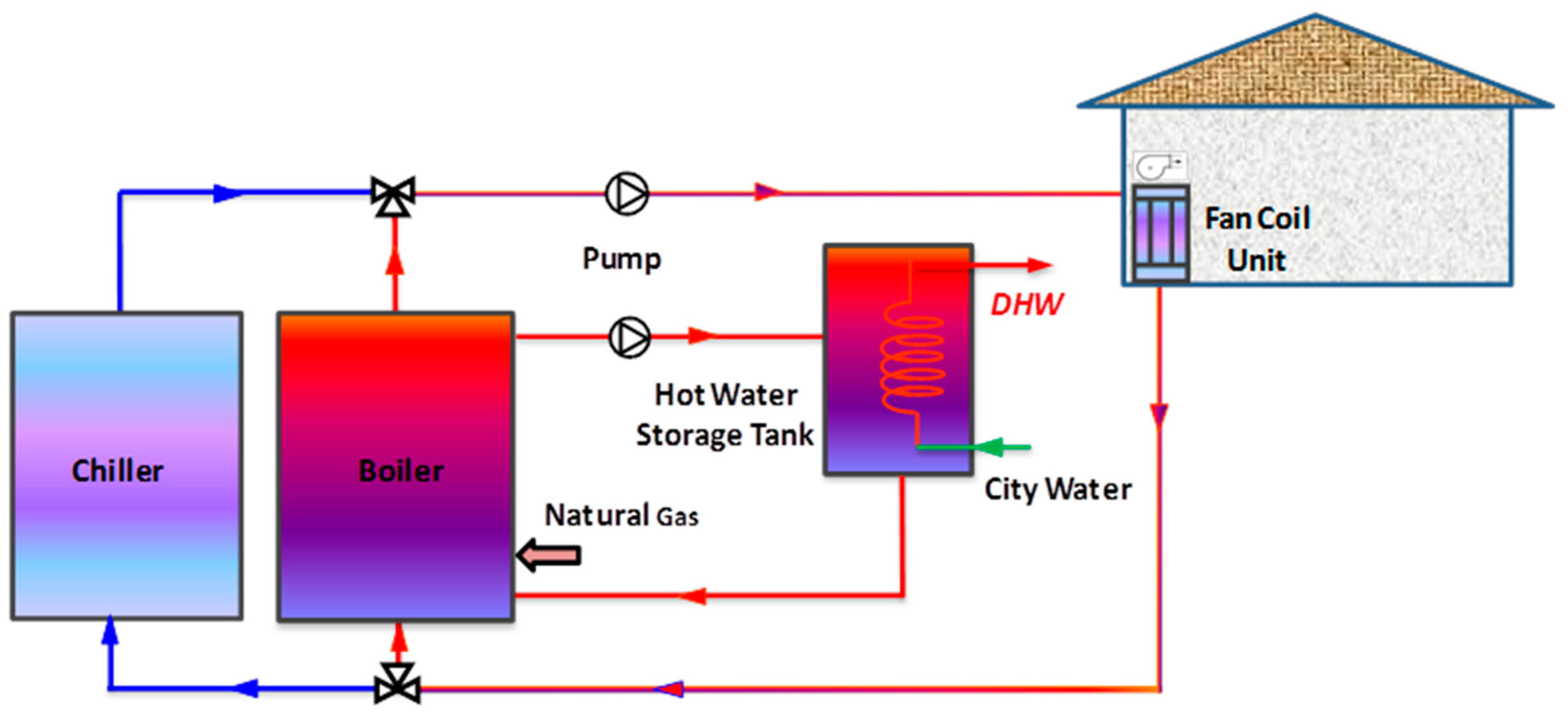
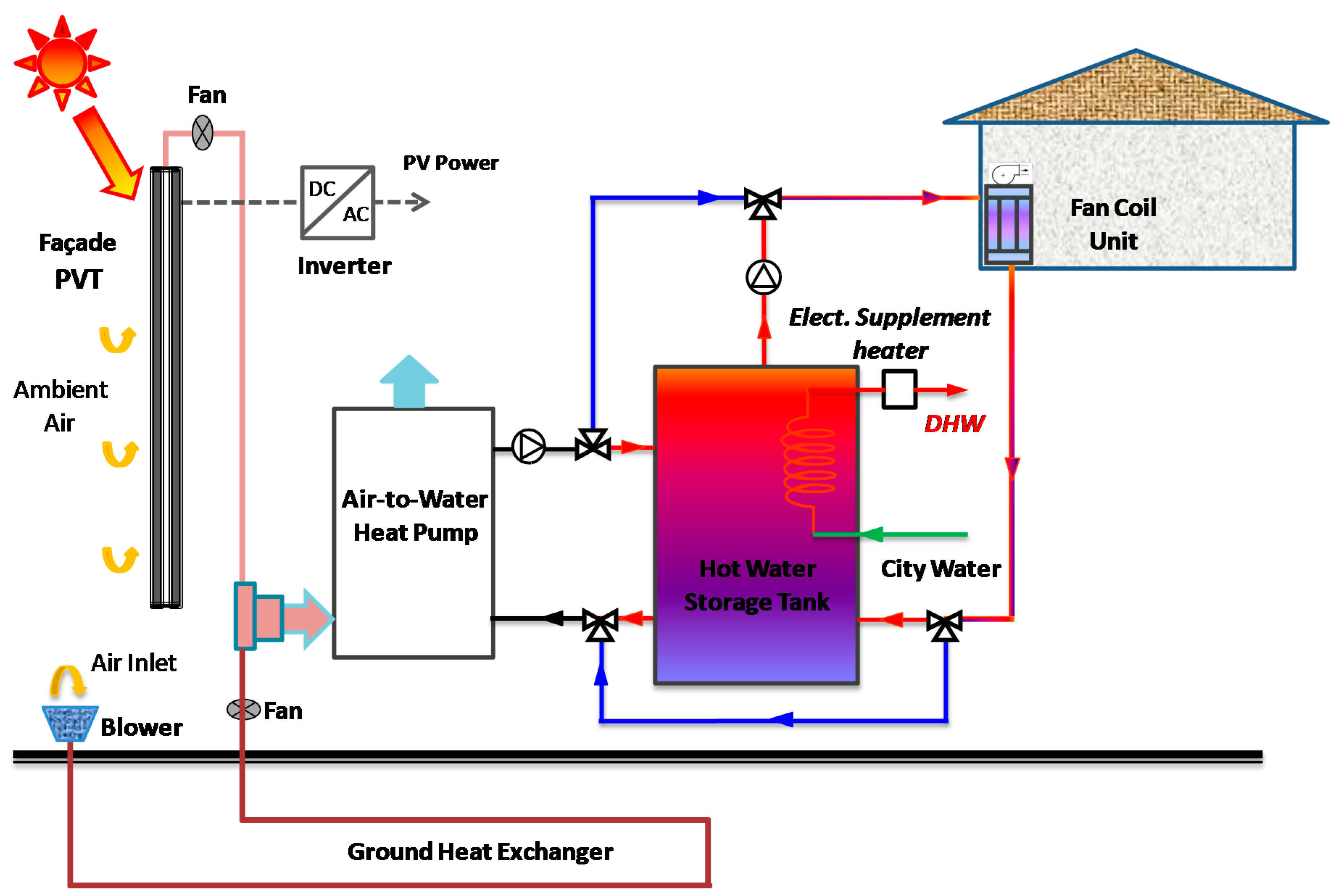
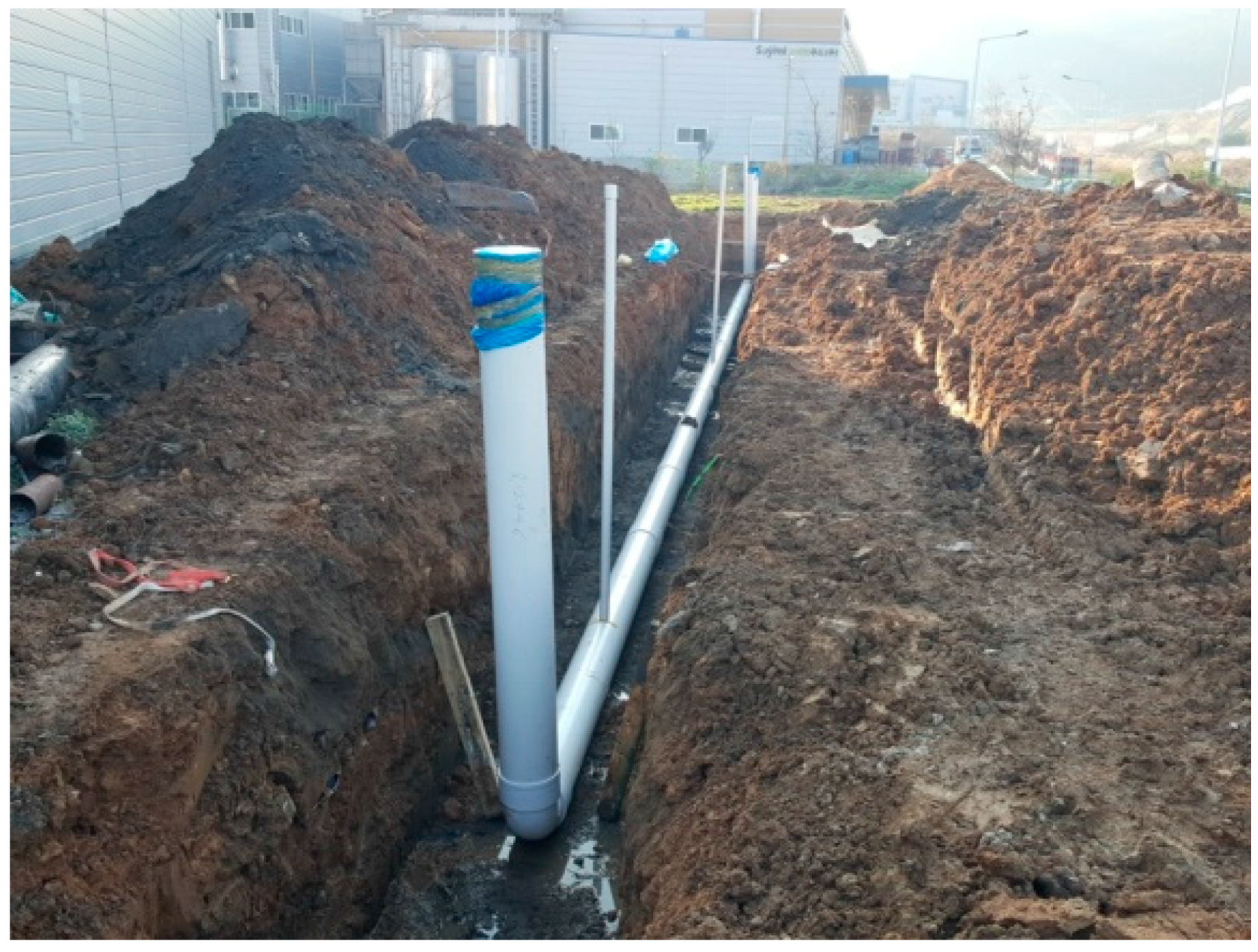

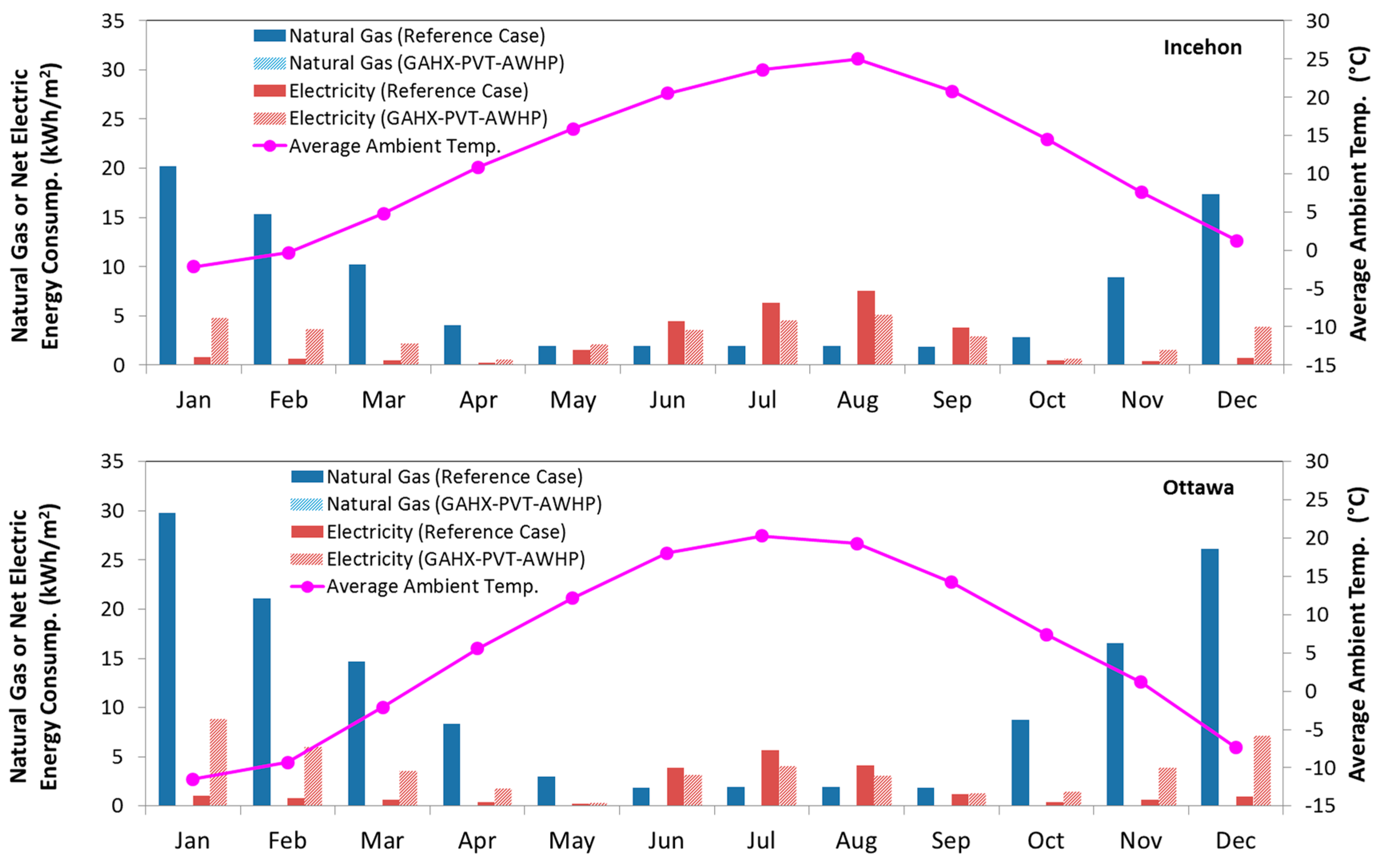


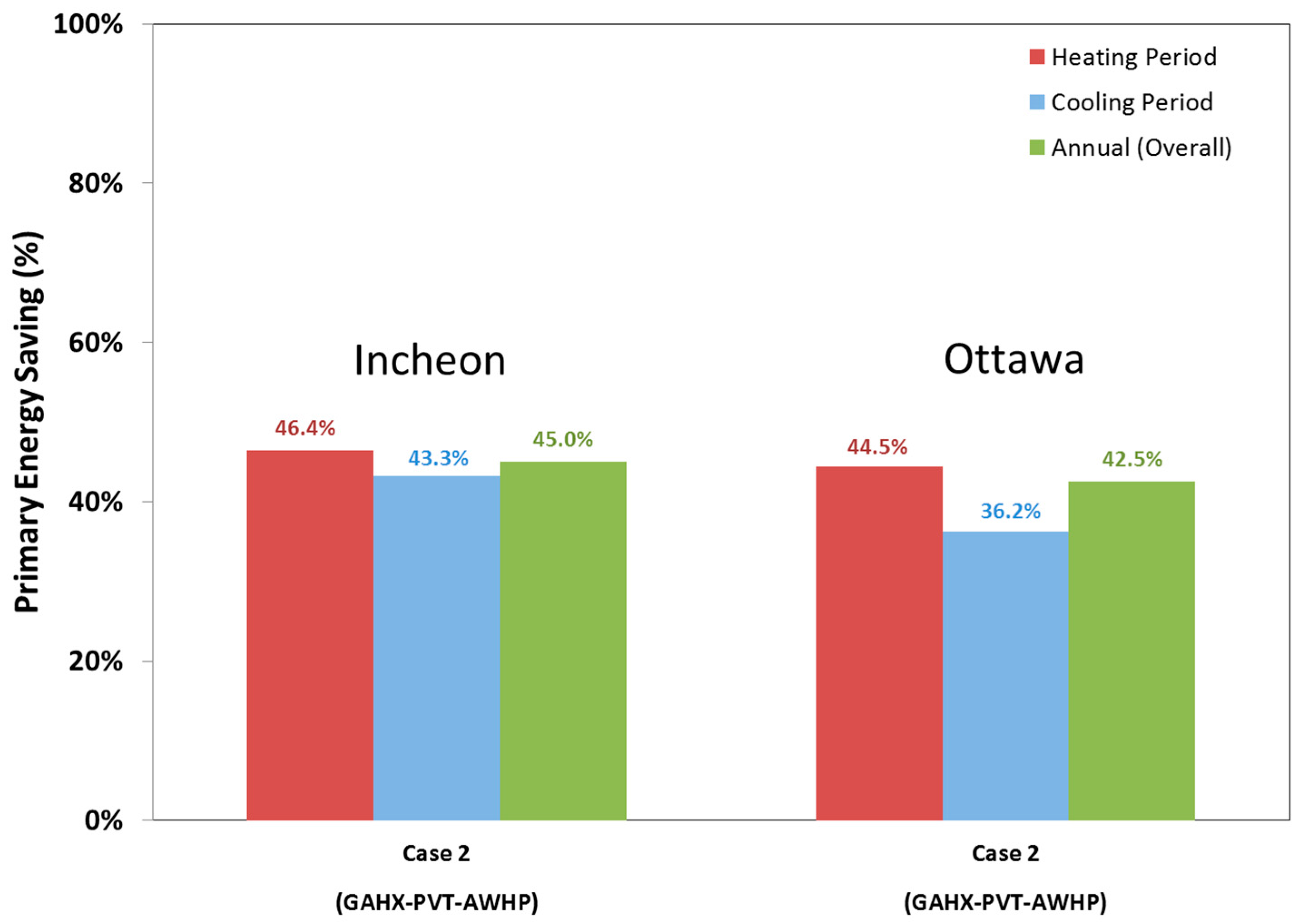
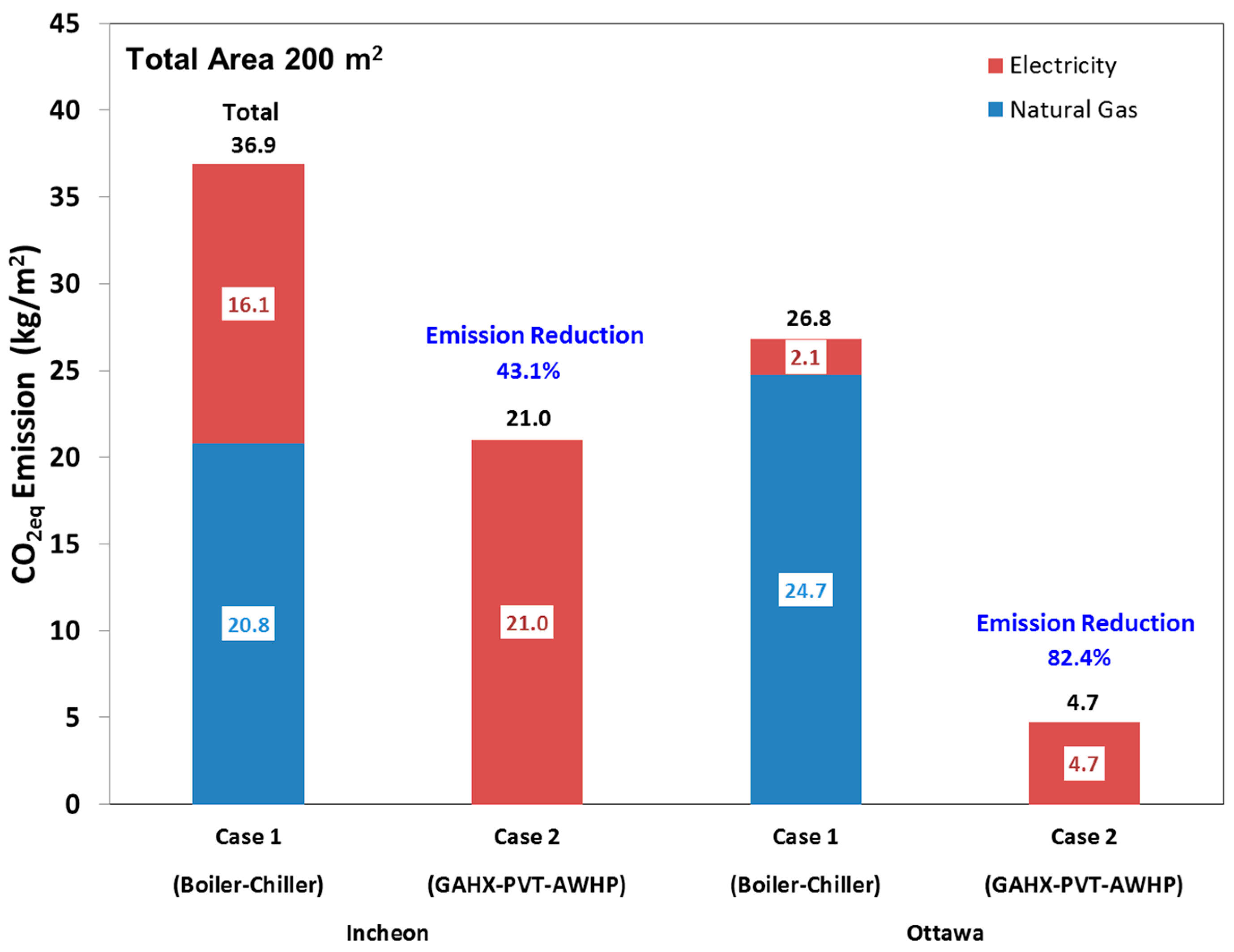
| Emission Factor (CO2eq g/kWh) | Incheon | Ottawa |
|---|---|---|
| Natural Gas | 235 | 182 |
| Grid Electricity | 590 | 106 |
| Heating | Cooling | ||
|---|---|---|---|
| Time period of day | Thermostat set-point | Time period of day | Thermostat set-point |
| 6:00–9:00, 16:00–22:00 | 21 °C | 9:00–16:00 | 26 °C |
| 0:00–6:00, 9:00–16:00, 22:00–24:00 | 18 °C | 0:00–9:00, 16:00–24:00 | 24 °C |
| Case 1 | Boiler | Chiller | ||
|---|---|---|---|---|
| ON | OFF | ON | OFF | |
| Heating Period | Troom ≤ Tset − 0.5 °C and/or T2 a ≤ 46 °C | Troom ≥ Tset + 0.5 °C and/or T5 a ≥ 49 °C | NA | NA |
| Cooling Period | T2 ≤ 46 °C | T5 ≥ 49 °C | Troom ≥ Tset + 0.5 °C | Troom ≤ Tset − 0.5 °C |
| Case 2 | AWHP | HP Inlet Air Preheating in PVT Mode a | Aux. Heater for DHW Heating | |||
|---|---|---|---|---|---|---|
| ON | OFF | ON | OFF | ON | OFF | |
| Heating Period | T8 b ≤ 40 °C | T8 b ≥ 45 °C | Tpvt − TGAHX ≥ 5 °C | Tpvt − TGHAX ≤ 2 °C | Tdhw < 49 °C | Tdhw ≥ 49 °C |
| Cooling Period | Troom ≤ Tset − 0.5 °C | Troom ≥ Tset + 0.5 °C | NA c | NA c | NA | NA |
| Thermal Load Intensity (kWh/m2) | Incheon | Ottawa |
|---|---|---|
| Space heating | 63.6 | 111.0 |
| Space cooling | 36.6 | 23.4 |
| DHW | 21.4 | 21.4 |
| City | Incheon | Ottawa | ||
|---|---|---|---|---|
| Period | Case 1 Boiler-Chiller | Case 2 GAHX-PVT-AWHP | Case 1 Boiler-Chiller | Case 2 GAHX-PVT-AWHP |
| Heating Period | 0.93 | 3.10 | 0.94 | 3.27 |
| Cooling Period | 1.45 | 2.52 | 1.48 | 2.27 |
| Annual Overall | 1.04 | 2.87 | 1.00 | 2.89 |
© 2016 by the authors; licensee MDPI, Basel, Switzerland. This article is an open access article distributed under the terms and conditions of the Creative Commons Attribution (CC-BY) license (http://creativecommons.org/licenses/by/4.0/).
Share and Cite
Kang, E.-C.; Lee, E.-J.; Ghorab, M.; Yang, L.; Entchev, E.; Lee, K.-S.; Lyu, N.-J. Investigation of Energy and Environmental Potentials of a Renewable Trigeneration System in a Residential Application. Energies 2016, 9, 760. https://doi.org/10.3390/en9090760
Kang E-C, Lee E-J, Ghorab M, Yang L, Entchev E, Lee K-S, Lyu N-J. Investigation of Energy and Environmental Potentials of a Renewable Trigeneration System in a Residential Application. Energies. 2016; 9(9):760. https://doi.org/10.3390/en9090760
Chicago/Turabian StyleKang, Eun-Chul, Euy-Joon Lee, Mohamed Ghorab, Libing Yang, Evgueniy Entchev, Kwang-Seob Lee, and Nam-Jin Lyu. 2016. "Investigation of Energy and Environmental Potentials of a Renewable Trigeneration System in a Residential Application" Energies 9, no. 9: 760. https://doi.org/10.3390/en9090760
APA StyleKang, E.-C., Lee, E.-J., Ghorab, M., Yang, L., Entchev, E., Lee, K.-S., & Lyu, N.-J. (2016). Investigation of Energy and Environmental Potentials of a Renewable Trigeneration System in a Residential Application. Energies, 9(9), 760. https://doi.org/10.3390/en9090760






